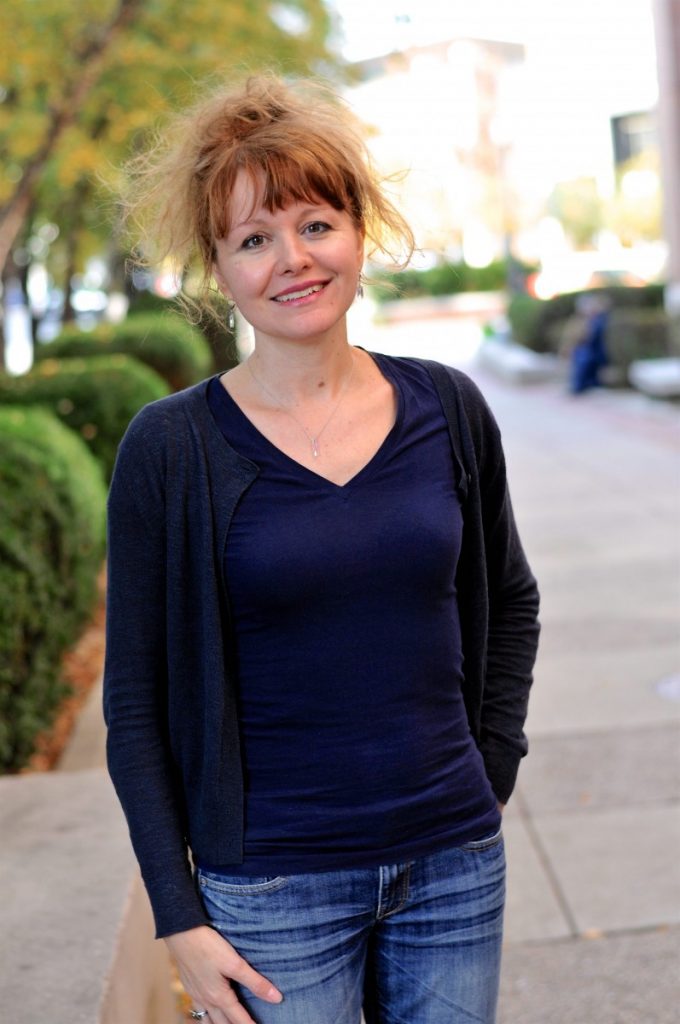
Longtime NER author Christine Sneed talks to our staff reader Malka Daskal about complex, nuanced, and seductive characters, the need for the heat of conflict, and about “The Swami Buchu Trungpa” (NER 41.1, 2020).
Malka Daskal: How did the idea for your story “The Swami Buchu Trungpa” germinate? In particular, I’m curious to hear what inspired you to write about a Swami, a character we don’t often see.
Christine Sneed: In the fall of 2018, right before I started writing this story, I read the novel You Deserve Nothing by Alexander Maksik, which I absolutely loved. It’s very sexy, controversial (there’s a student-teacher affair), beautifully spare and arresting, and is set in contemporary Paris. While reading it I thought, “I haven’t written any fiction set in Paris in several years, so . . . I want to go back there and see what happens.” The first sentence arrived soon after.
I consciously tried to write an opening line that would point to the source of one of the story’s primary conflicts or themes. Alcohol and its omnipresence in Midwestern culture (well, American culture on the whole)—I’d be hard-pressed to find a social gathering or sporting event in the Midwest that doesn’t feature the opportunity to get soused—these are aspects I have familiarity with, having lived in the Chicago sprawl for most of my life (until a couple of years ago)—and once I knew what the voice and point of view were, and had a sense of the story’s narrative trajectory, I started writing in earnest.
MD: In “Swami,” Nora strains under the competing demands of the two people she loves most, Buchu and her mother, each of whom are convinced she would be happier without the other. Caught between these two powerful forces, Nora could easily be dismissed as a passive victim, but instead she comes across as modern, intelligent, and formidable. Where do you find compassion for your characters and how do you calibrate the story to ensure readers feel the same compassion?
CS: As I suspect is true for many of us, I know a number of people who have had problems with drugs and alcohol, and although this story isn’t based on a friend or family member, I did try to make each of the main characters, especially Regina, who struggles with alcoholism, as complex and nuanced as I could.
Specificity and precision are two of the qualities I most admire in the books by authors I love, and in my own writing I try hard to make the external world and the characters’ interior lives as specific and exact as possible—the character doesn’t just wear a sweater, she’s in a mauve cardigan with a stained sleeve. It always pains me when someone says during a workshop, “Oh, there are too many details in this story.” That’s almost never true—at least not in the work of novice writers. The details are where the personality and the real life of the character reside. If I draw my characters with enough specificity, I’m going to love them. If I don’t love them, I know I haven’t done the necessary work yet.
MD: “Swami” reminds me of another short story of yours, “Quality of Life,” published in your collection Portraits of a Few of the People I’ve Made Cry. Both feature women attracted to older, charismatic, yet fundamentally unavailable men who take more than they give and use control as a substitute for love. Buchu even claims the story’s title! What draws you to writing these kinds of characters and the emotional fallout of their stubborn selfishness on the women who try to love them?
CS: That story was originally published in New England Review, coincidentally!
What draws me to these tricky male characters is their ability to make other people—women especially—adore them and do things that are not necessarily good for them. I think often of something I heard Mike Nichols say during an interview: a scene should be a seduction, an argument, or a negotiation. He was speaking about film (and perhaps stage plays), but it applies to fiction too, especially when we’re looking at domestic realism; regardless, I think it’s a helpful suggestion for fiction writers. I don’t always adhere to this stricture, but I do like the idea of seductive characters, and there’s at least one sexy jerk in many of the stories I’ve written.
You need the heat of conflict if you’re going to have a story people will want to read, and the conflict generally comes from a flaw—whether it’s greed or arrogance or selfishness or a tendency toward jealousy and violence.
MD: The character of Regina, Nora’s mother, is superbly and comically brought to life through her clever quips and stinging barbs. Her frank and overbearing love serves as the perfect foil to Buchu’s cold detachment. The dialogue between Nora and Regina was a great pleasure to read. What is your process for writing dialogue and how do you discover your characters’ voices?
CS: I really love writing dialogue, and if I have the voice of the character in my head and can picture them, the dialogue usually unspools more or less organically. As soon as I wrote the line Regina says early in the story about Paris having a lot of old drunks (and by extension, AA meetings), I knew I had a good feel for who she was.
One thing I’m always on the lookout for, however, is sitcom-like dialogue. I love sitcoms, but in fiction, the flippant goofball character can come across as very mannered. Onscreen, you have the actor and everyone knows it’s a performance, but on the page, the performative aspect, the set design, the music, etc., are missing. The words are judged on their own, and so you have to work harder to make sure they don’t sound hollow.
Reading them aloud helps me sometimes, as does critical distance—which can’t really be rushed. You’re not going to spot what sounds cheesy until you’ve had some time away from the story. For some writers, it might only be a few hours or days before they know something isn’t ringing true. For others, it might be months, or even longer. The drive to send out new work right away that many of us feel—I’m not exempt, that’s for sure—isn’t helpful either. Writing well takes time. Or at least knowing when something you’ve written is ready for others to see.
MD: You mentioned in our correspondence that this story had gone through extensive revisions before arriving at its published form. I have always been fascinated by the evolutionary process of a story. Can you share with us the ways in which this story evolved? What significant changes were made and how and why did you choose to make those changes?
CS: One thing that happened was my partner Adam read the first draft of the story—he’s my first reader and although he’s not a writer, he has an uncanny ability to pinpoint a problem or suggest a solution for a work in progress. He’s been a serious Zen Buddhist for more than twenty years, and through his practice he’s encountered Swami Buchu–like people. After reading this first draft, he said, “The swami doesn’t strike me as . . . well, he’s not working for me.” And I thought, “Huh. Okay . . .”
I sat with that assessment for a week or so before I began rewriting the story to make Buchu a less cartoonish figure. I also spent more time developing Regina’s role, as well as Nora’s complicated feelings about her.
After Carolyn Kuebler accepted the story, she and I worked even more on the swami’s characterization and Nora’s response to him. It was so helpful to have her suggestions, needless to say. For one, I realized that ironic distance was a problem—I was still too far removed from the swami and needed to make it clear why Nora had ever bothered with him at all.
Lastly, I wanted Regina to be a little more sympathetic too. With Nora being pulled back and forth between Regina and Buchu, I had to figure out how to make them both alternately seductive and somewhat repellent.
MD: I like to consider the ways in which contemporary writers are a part of a linked heritage; an author’s DNA is imprinted upon by the works of the previous generation and then made manifest in their craft, a sort of literary ancestry. Who do you consider your literary influencers and how do the works you admire shape the content and form of your stories?
CS: A few of the writers whose work I haven’t been able to put down over the last several years: Rachel Cusk, David Szalay, Scott Spencer, Joan Silber, and before that, Penelope Fitzgerald, John Updike, Edward P. Jones, Penelope Lively, and always always always Alice Munro. When I find a writer whose work I love, I try to read all of it—or in the case of the steadily prolific Updike, at least half of it.
Updike and Spencer in particular have taught me about beautiful sentences and imagery. And they are both writers who have no fear of writing about sex, desire, and sensuality. I am often drawn to these themes too—not as much in “Swami Buchu,” but in other stories I’ve written, and my two novels for sure.
Munro’s expansiveness has been something I aspire to as well-—she writes long short stories (an oxymoron!), but in these stories, she has more depth than can be found in many novels. She’s brilliant. And also often very funny. And profoundly sympathetic.
And regarding Updike, who once said his default mode is the comic—I aspire to this too.
Christine Sneed’s stories have appeared in New England Review and have been included in The Best American Short Stories and The O. Henry Prize Stories anthologies. Her most recent book is The Virginity of Famous Men (Tortoise Books, 2017). She lives in Pasadena, California.
Malka Daskal received her master’s degree from Columbia University and was the recipient of the Maricopa Artist of Promise Award in 2016. Her work has appeared in Bookends Review, Passages, and the Traveler and is forthcoming in Kind Writers and december. She lives in Phoenix, Arizona, with her husband and two sons.
